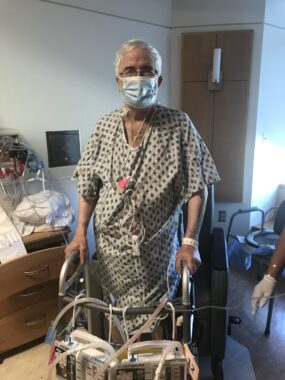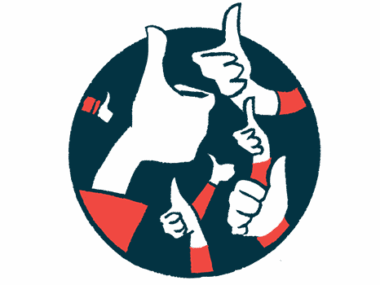Remembering my first 10 days of transplant recovery
3 years ago this month, I got new lungs and began walking to independence
Written by |

About 28 or 29 hours after the completion of my bilateral lung transplant, I was extubated. I took my first breath on my own with my new lungs. It was the beginning of my road to recovery.
When I was diagnosed with idiopathic pulmonary fibrosis (IPF) in January 2017, it soon became apparent that I needed to work harder to be fit enough for a lung transplant. I spent three days a week in pulmonary rehabilitation; for the other four days, I walked on my own in my community. When I’d used all of my insurance allocation of pulmonary rehabilitation sessions, I enrolled in a rehabilitation maintenance program at my own expense. I believe these sessions were the foundation for my recovery.
Following my lung transplant, I remained in the hospital for 10 days. I had my transplant on July 10, 2021, and was discharged on July 20, 2021. Each of us experiences a different journey after a transplant. Not everyone is going to be discharged quickly from the hospital to the home. Some will remain there for months or be discharged to a rehabilitation facility until they’re ready to go home.
First steps toward recovery
When I was extubated on July 11, I was in the intensive care unit (ICU). The next day, teams from physical therapy and respiratory therapy descended on me. I was out of bed and standing with assistance on July 12. I was taught how to stand up and sit down. I was taught how to protect my surgery incision if I fell. The day after that, I was sitting up and expected to take small steps to reach a chair. At this point, these steps were assisted. The respiratory therapist brought a pedal machine to be placed in front of the chair.
Within days, I graduated from the ICU and was moved to a “step-down” unit. I started out taking walks around the unit with a walker and other assistance. Equipment could be hung on the walker as I took my steps, and an IV pole accompanied me.

Six days after my transplant I was up and walking. (Courtesy of Sam Kirton)
As I became stronger, my walks became laps around the unit without a break. I initially held the IV pole as I moved with it. Soon the unit’s nurses urged me to do more, and I was allowed to walk around the hospital unit by myself. As I became more comfortable with that, the unit’s nurses became more comfortable with me moving toward independence.
The two milestones that were most significant to me came shortly before I was discharged. First, I was able to use the toilet without assistance, which was liberating. If you’ve never required assistance to use a toilet, I’m not certain I can explain how freeing that was. The final test of my prowess before discharge required that I safely climb and descend stairs. I was able to do that on my first attempt.
My transplant preparation helped in my recovery. My care instructions were prefaced with two words: “at least.” They wanted 30 minutes of exercise from me at least three days a week. I felt the need to push myself even more. My personal program had me doing some form of exercise at least six days a week. It wasn’t unusual to log seven consecutive days of exercise.
Before my transplant, my need for supplemental oxygen was increasing. In the pulmonary rehabilitation sessions in the hospital, I was using oxygen. On days when I exercised on my own, I’d pull supplemental oxygen tanks behind me on a wheeled tank cart.
I was making an investment in me.
Last Wednesday, July 10, was the three-year anniversary of my lung transplant. Every day I still work hard to ensure I care for the lungs my donor entrusted me with. I’ll continue to exercise that same level of care for my donor lungs so I can make every breath count.
Note: Pulmonary Fibrosis News is strictly a news and information website about the disease. It does not provide medical advice, diagnosis, or treatment. This content is not intended to be a substitute for professional medical advice, diagnosis, or treatment. Always seek the advice of your physician or other qualified health provider with any questions you may have regarding a medical condition. Never disregard professional medical advice or delay in seeking it because of something you have read on this website. The opinions expressed in this column are not those of Pulmonary Fibrosis News or its parent company, Bionews, and are intended to spark discussion about issues pertaining to pulmonary fibrosis.








Steve McCown
Samuel, thank you for the insights provided. It is so helpful to be reminded as to the importance of the pre-transplant exercise. I will be added the Emory Hospital (Atlanta, GA) approved lung transplant list at the end of this month. I will be 68 in August, but I am a disciplined, goal-oriented person who is determined to over-achieve during the recovery phase. It sounds like a daunting process, full of incredible challenges, but as an alternative to worsening IPF, it is a God-send of an alternative. I am open to any additional tips or words of advice as I prepare for this significant event. Keep up the great work, sir. It certainly sounds like you have embraced the actions necessary for a highly-successful, long-term recovery. I wish you well.
- Steve McCown, Duluth, GA
Samuel Kirton
Hi Steve,
Thanks for reading my column and for your comments. I do not want to spoil next weeks column (7/23/2024) so you might want to come back. It might have a couple of additional tips you will find useful.
Sam ...
Paul Hendrickson
Hi Sam, my journey to transplant was very similar to yours but I was diagnosed on April 16th of 2014 and received a double lung transplant on Feb 24th of 2024.. very close to ten years… Yes fitness is the major key to success with transplant I was still playing high end hockey three times per week up to 2021 golfing Thursdays cycling and skiing until I couldn’t take the altitude..anymore..and working out as you did in rehab in the hospital two days per week, and at home on the other days.. My transplant was very close to your timeline in hospital with an extra two days and climbing stairs the day I left was part of the process as well. The medication is certainly a rapid learning skill and my wife still helps me stay organized there but it does get better as well.. I’m just about 5 months out now and cutting my large yard of grass walking daily and rehab twice a week now and was just givin the green lite to start skiing again ….to your point.. there is no replacement for fitness in the ILD world and doing everything possible pre transplant is really a big key to the success… thanks for sharing your experience.. Paul .. Vancouver Canada..
Samuel Kirton
Hi Paul,
Thanks for reading my column and for your comments. It sounds like you are thriving. Continue to do all you can to make every breath count.
Sam ...